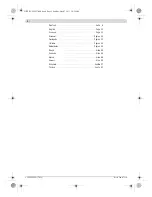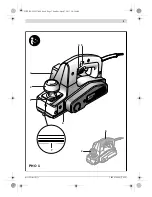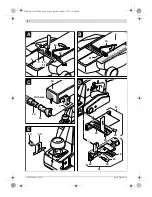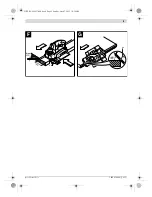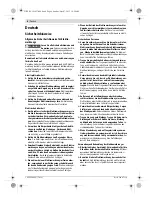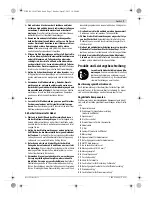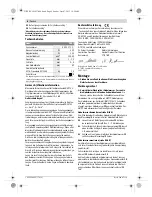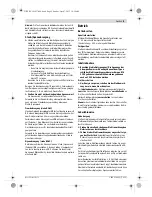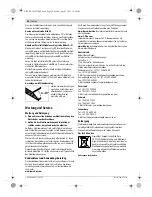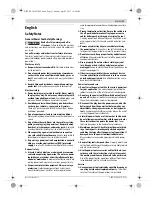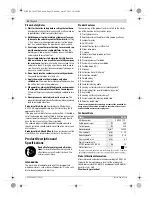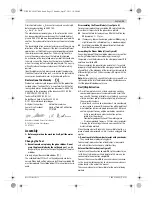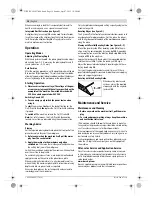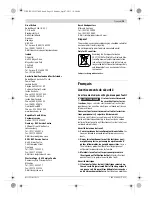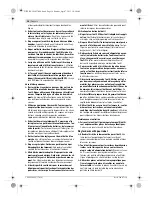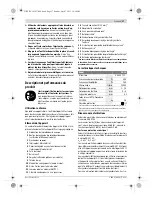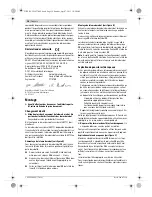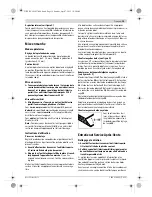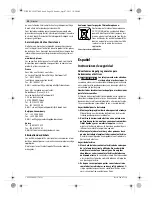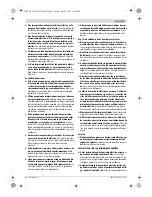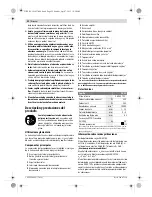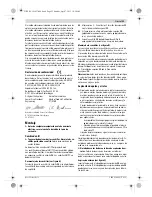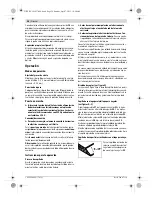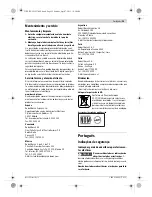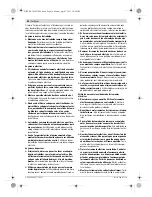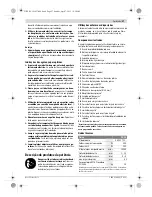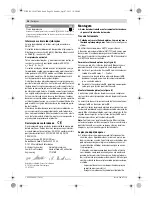
English |
13
Bosch Power Tools
1 609 92A 06V | (7.4.13)
Vibration total values a
h
(triax vector sum) and uncertainty K
determined according to EN 60745:
a
h
=6 m/s
2
, K=2 m/s
2
.
The vibration emission level given in this information sheet
has been measured in accordance with a standardised test
given in EN 60745 and may be used to compare one tool with
another. It may be used for a preliminary assessment of expo-
sure.
The declared vibration emission level represents the main ap-
plications of the tool. However if the tool is used for different
applications, with different accessories or poorly maintained,
the vibration emission may differ. This may significantly in-
crease the exposure level over the total working period.
An estimation of the level of exposure to vibration should also
take into account the times when the tool is switched off or
when it is running but not actually doing the job. This may sig-
nificantly reduce the exposure level over the total working
period.
Identify additional safety measures to protect the operator
from the effects of vibration such as: maintain the tool and the
accessories, keep hands warm, organise work patterns.
Declaration of Conformity
We declare under our sole responsibility that the product de-
scribed under “Technical Data” is in conformity with the fol-
lowing standards or standardization documents: EN 60745
according to the provisions of the directives 2011/65/EU,
2004/108/EC, 2006/42/EC.
Technical file (2006/42/EC) at:
Robert Bosch GmbH, Postfach 10 01 56,
D-70745 Leinfelden-Echterdingen
Robert Bosch GmbH, Power Tools Division
D-70745 Leinfelden-Echterdingen
13.07.2011
Assembly
Before any work on the machine itself, pull the mains
plug.
Changing the Tool
Be cautious when replacing the planer blades. Do not
grasp the planer blades by the cutting edges.
Possible
danger of injury due to the sharp cutting edges of the plan-
er blades.
Use only original Bosch carbide blades (TC).
The carbide blade (TC) has 2 cutting edges and can be re-
versed. When both cutting edges are dull, the planer blade
12
must be replaced. The carbide blade (TC) may not be resharp-
ened.
Disassembling the Planer Blade(s) (see figure A)
To reverse or replace the planer blade
12
, rotate the blade
drum
9
until it is parallel to the planer base plate
6
.
Loosen the two fastening screws
11
with the Allen key
13
by approx. 1 – 2 turns.
If necessary, loosen the clamping element
10
by giving it
a light blow with a suitable tool (e.g. a wooden wedge).
Push the planer blade
12
sidewards out of the blade
drum
9
with a piece of wood.
Assembling the Planer Blade(s) (see figure B)
The guide groove of the planer blade always ensures continu-
ous height adjustment when replacing or reversing it.
If required, clean the blade seat in the clamping element
10
and the planer blade
12
.
When assembling the planer blade, ensure that it is seated
properly in the blade holder of the clamping element
10
and
aligned flush at the side edge of the rear planer base plate
6
.
Afterwards tighten the 2 fastening screws
11
again with the
Allen key
13
.
Note:
Before restarting, check if the fastening screws
11
are
tightened well. Rotate the blade drum
9
by hand and ensure
that the planer blade does not graze.
Dust/Chip Extraction
Dusts from materials such as lead-containing coatings,
some wood types, minerals and metal can be harmful to
one’s health. Touching or breathing-in the dusts can cause
allergic reactions and/or lead to respiratory infections of
the user or bystanders.
Certain dusts, such as oak or beech dust, are considered
as carcinogenic, especially in connection with wood-treat-
ment additives (chromate, wood preservative). Materials
containing asbestos may only be worked by specialists.
– As far as possible, use a dust extraction system
suitable for the material.
– Provide for good ventilation of the working place.
– It is recommended to wear a P2 filter-class respirator.
Observe the relevant regulations in your country for the
materials to be worked.
Clean the chip ejector
3
regularly. Use a suitable tool (e.g., a
piece of wood, compressed air, etc.) to clean a clogged chip
ejector.
Do not reach into the saw dust ejector with your hands.
They could be injured by rotating parts.
To ensure optimum extraction of dust/chips, always work
with external dust extraction or a chip/dust bag.
External Dust Extraction (see figure C)
Firmly attach the extraction adapter
15
to the sawdust ejec-
tor
3
. An extraction hose with a diameter of 35 mm can be
connected to the extraction adapter
15
.
Connect the vacuum hose
14
to a vacuum cleaner (accesso-
ry). An overview for connecting to various vacuum cleaners
can be found at the end of this manual.
The vacuum cleaner must be suitable for the material being
worked.
Dr. Egbert Schneider
Senior Vice President
Engineering
Helmut Heinzelmann
Head of Product Certification
PT/ETM9
OBJ_BUCH-437-004.book Page 13 Sunday, April 7, 2013 10:58 AM


